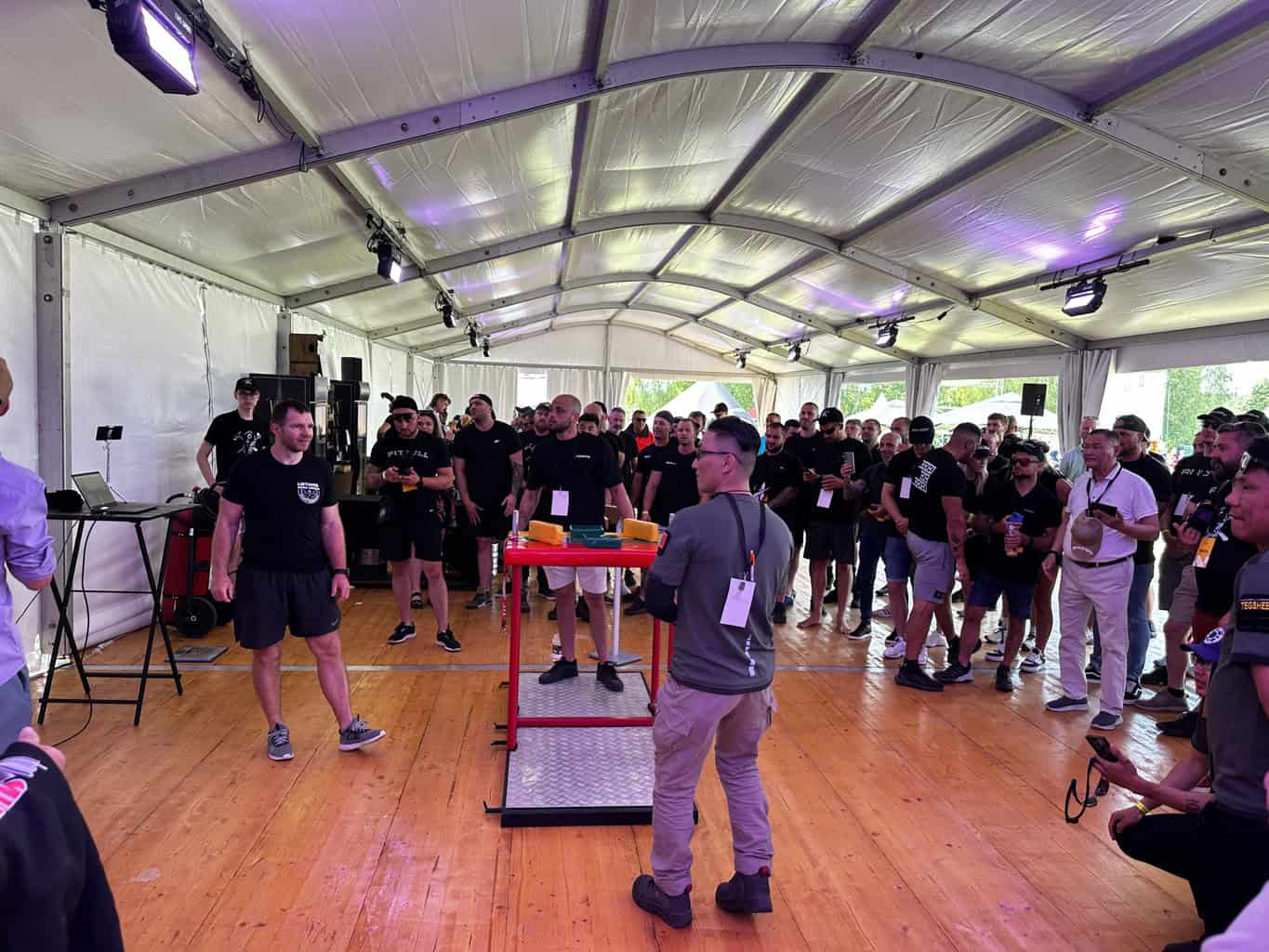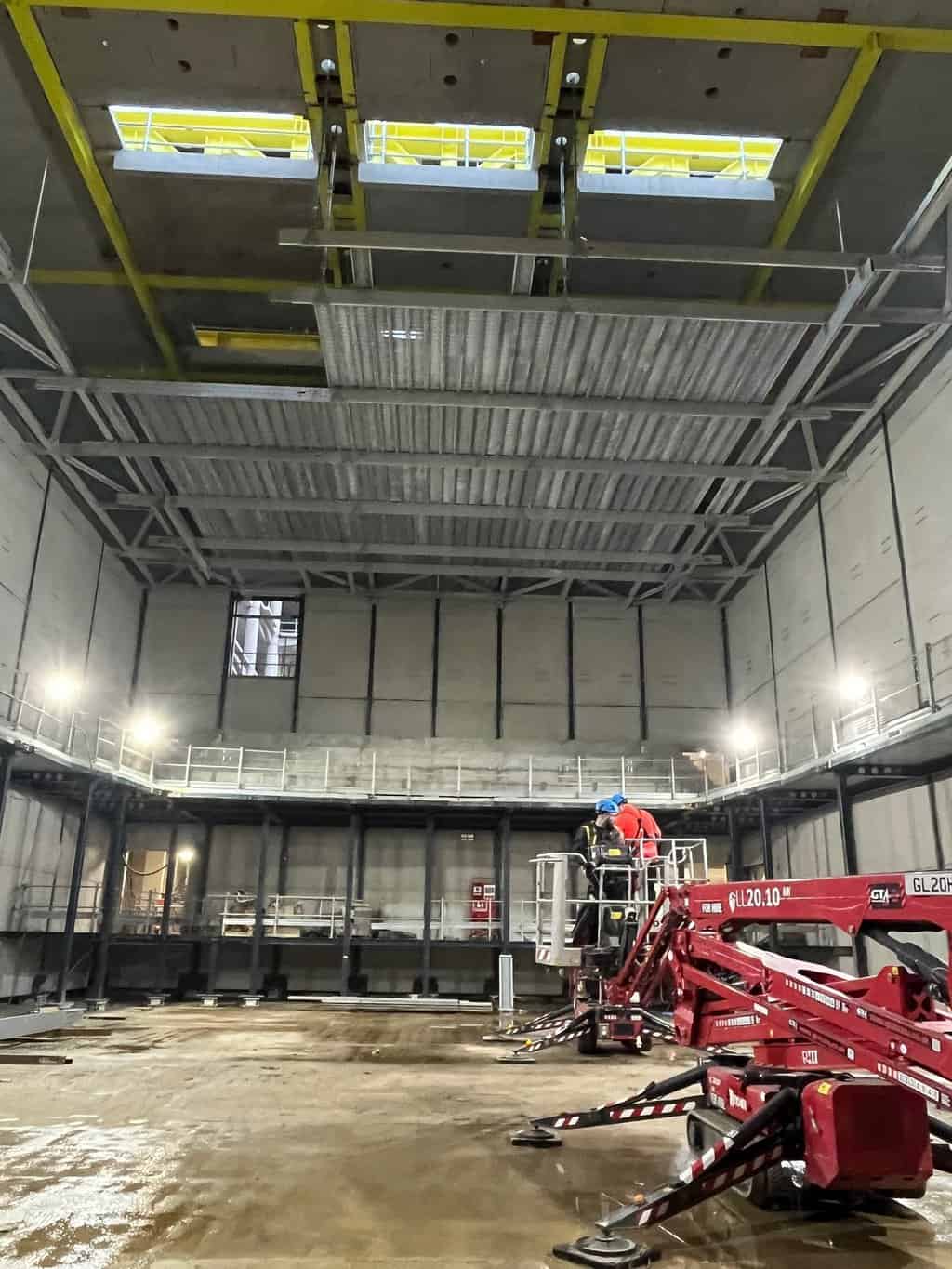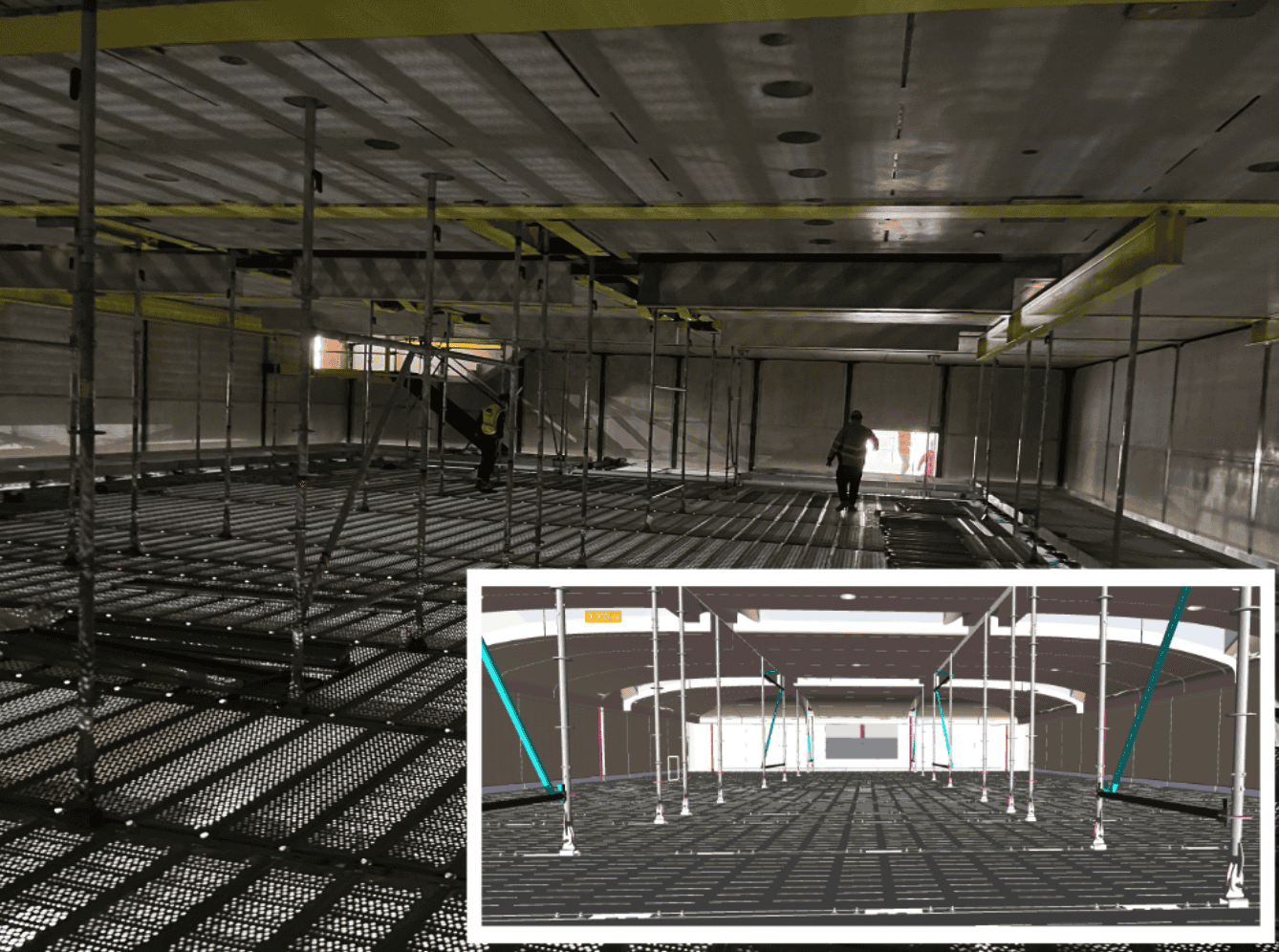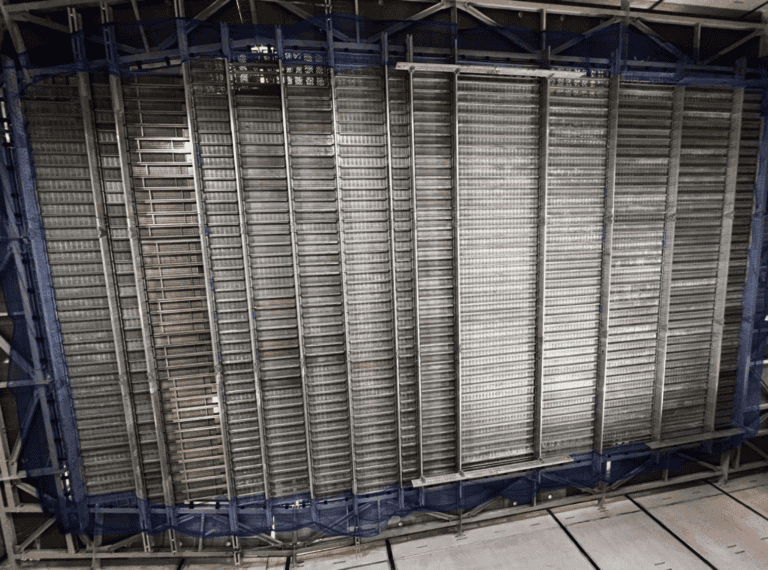ScaffChamp 2024 Kicks Off with a Fun-Filled Day in Sunny Vilnius
The picturesque city of Vilnius basked in the sunshine today as it welcomed scaffolders from around the world for the much-anticipated ScaffChamp 2024.
The first day of the event, dubbed the “Fun Day,” provided an enjoyable start for participants and attendees alike, blending leisure with anticipation as competing teams discovered their upcoming challenges. Scaffolders gathered at the event grounds at Layher Baltic to engage in a variety of activities designed to foster camaraderie and showcase their skills in a relaxed community setting. Highlights included an arm wrestling contest that drew spirited participation and cheers from the crowd and an intense obstacle course that tested the competitors’ agility, strength, and teamwork.
 The grand reveal of the competition’s scaffolding challenge was one of the day’s main attractions. For the first time, teams were shown 4D designs of what they have to build, courtesy of the main sponsor ScaffPlan.
These hi-tech designs, accessible via a QR code, provided a detailed and interactive view of the structures, allowing teams to start planning and strategising immediately. The announcement was met with a mix of both excitement and strategic planning as teams began to formulate their approaches and discuss potential strategies for the scaffold build.
The grand reveal of the competition’s scaffolding challenge was one of the day’s main attractions. For the first time, teams were shown 4D designs of what they have to build, courtesy of the main sponsor ScaffPlan.
These hi-tech designs, accessible via a QR code, provided a detailed and interactive view of the structures, allowing teams to start planning and strategising immediately. The announcement was met with a mix of both excitement and strategic planning as teams began to formulate their approaches and discuss potential strategies for the scaffold build.

 Adding to the atmosphere, the day featured a live DJ, a bar and local food offering Lithuanian delicacies, and a special exhibition of the latest scaffolding technologies and innovations. Leach’s and KEWAZO were among the exhibitors, showcasing their latest products and solutions to an eager audience.
Attendees had the opportunity to network, exchange ideas, and gain insights into cutting-edge advancements that are shaping the future of the scaffolding industry.
Scaffmag had the opportunity to catch up with the three UK teams competing for the first time ever at ScaffChamp: Star Scaffolding, Connect Scaffolding, and Rose System Scaffolding.
Adding to the atmosphere, the day featured a live DJ, a bar and local food offering Lithuanian delicacies, and a special exhibition of the latest scaffolding technologies and innovations. Leach’s and KEWAZO were among the exhibitors, showcasing their latest products and solutions to an eager audience.
Attendees had the opportunity to network, exchange ideas, and gain insights into cutting-edge advancements that are shaping the future of the scaffolding industry.
Scaffmag had the opportunity to catch up with the three UK teams competing for the first time ever at ScaffChamp: Star Scaffolding, Connect Scaffolding, and Rose System Scaffolding.

 The teams expressed their excitement about participating in the international event and shared their thoughts on the day’s activities and the upcoming competition. “It’s a fantastic experience to be here and see the global scaffolding community come together,” said a representative from Star Scaffolding. “We can’t wait to show what we’ve got in the competition.”
The teams expressed their excitement about participating in the international event and shared their thoughts on the day’s activities and the upcoming competition. “It’s a fantastic experience to be here and see the global scaffolding community come together,” said a representative from Star Scaffolding. “We can’t wait to show what we’ve got in the competition.”
Safety is Paramount this Year
This year’s event marks a stark contrast to last year, with a heightened emphasis on safety. Organisers have implemented comprehensive method statements and Risk Assessment Method Statements (RAMS) to ensure all activities are conducted with the utmost care and adherence to safety guidelines. This focus on safety reflects a growing awareness and commitment to protecting the well-being of all participants.
Team Draw
A highlight of the day was the team draw for ScaffChamp, powered by Layher. The draw rule ensured that teams from the same country wouldn’t participate in the same round. Here are the results: 1st Round:- Telinetiimi (Finland)
- Látvány-Állvány (Hungary)
- STAR SCAFFOLDING (UK)
- XPRTS (Bulgaria)
- Alpaccess (Romania)
- Björli Team (Sweden)
- RNDV (Lithuania)
- Cumiskey Scaffolding (Ireland)
- Connect Scaffolding (UK)
- N-Projects (Poland)
- HOTREMA (Lithuania)
- Stilladsarbejdernes Landsklub (Denmark)
- Starteline (Finland)
- KAEFER Sweden (Sweden)
- GLT (Poland)
- Kukla Scaffolding (Slovakia)
- Stabil Épít? (Hungary)
- Globalita (Lithuania)
- Rose System Scaffolding (UK)
- PDV INŽENJERING (Serbia)
- NBIK (Mongolia)
End of Day 1
As the sun sets over Vilnius, the energy remained high, with scaffolders and spectators looking forward to tomorrow’s main event. Over 500 people are expected to attend as the official competition kicks off. The final day promises a showcase of skill, precision, and teamwork as teams vie for the coveted ScaffChamp 2024 title. Stay tuned for more updates as we continue our live coverage of ScaffChamp 2024. Follow the live blog, which will bring you the latest news and highlights from this exciting event.Live Blog: ScaffChamp 2024
Welcome to Scaffmag’s live coverage of ScaffChamp 24, coming to you from the vibrant city of Vilnius, Lithuania!
This year’s ScaffChamp promises to be an exhilarating event, bringing together the best in the scaffolding industry from around the globe. Over the next few days, we’ll be your eyes and ears on the ground, providing real-time updates, exclusive interviews, and behind-the-scenes insights into the competitions, innovations, and industry discussions that make ScaffChamp 24 a must-follow event.TRAD Scaffolding Sees 15% Boost in Pre-Tax Profit Amid Positive Future Outlook
Kent-based TRAD Scaffolding has posted a significant 15% increase in its pre-tax profit for the year ending 31 August 2023, alongside a positive outlook for the coming months.
According to Construction News, the company’s latest financial accounts reveal a pre-tax profit of £3.27 million, up from £2.84 million in 2022. Despite a modest 2% rise in turnover, reaching £14.9 million compared to £14.6 million the previous year, the scaffolding firm experienced notable growth in activity during the third and fourth quarters. TRAD attributed this growth to an increase in the volume of projects and a robust pipeline of upcoming work despite facing a competitive market environment with aggressive pricing. The company’s strategic report highlights ongoing challenges in the construction market, particularly labour shortages. To counteract these issues, TRAD Scaffolding’s directors are focusing on recruitment and training strategies to ensure the company can meet demand and maintain service quality. As of August 2023, the firm reported a cash balance of £2.86 million and net assets totalling £10 million. The company’s debt to creditors decreased by 6% to £6.22 million, down from £6.6 million in 2022. However, the company’s workforce significantly reduced, with employee headcount dropping 19% from 147 in 2022 to 119 in 2023. Correspondingly, total staff costs, including wages, salaries, social security contributions, and pension contributions, fell by 27% to £6.12 million from £8.39 million the previous year. TRAD Scaffolding is owned by TRAD Group Ltd, was recently ranked fourth in Construction News’ index of the top 10 scaffolding contractors. The financial report, signed by Director Peter McShane, reflects the company’s strategic efforts to navigate market challenges and capitalise on growth opportunities. As TRAD Scaffolding looks ahead, its strong pipeline of projects and focused recruitment and training strategies position it well to continue its upward trajectory in the competitive scaffolding industry.Hydrajaws Expands Digital Excellence with Launch of Verify Torque
Hydrajaws, a leader in pull testing technology, has introduced the Verify Torque adaptor, a significant enhancement to its digital solutions portfolio.
This cutting-edge Bluetooth®-enabled torque wrench adaptor is set to revolutionise compliance and traceability in torque testing by integrating seamlessly with existing tools.
Since introducing the industry’s first reporting app in 2016, Hydrajaws has consistently led the way in bringing digital advancements to pull testing. The company’s latest innovation, the Verify Torque adaptor, now extends this digital excellence to torque testing, ensuring precise and reliable torque measurements that enhance the installation process of anchors.
The Verify Torque adaptor empowers users to effortlessly capture torque data effortlessly via a dedicated reporting app. This app not only ensures all measurements align with manufacturers’ recommendations but also provides comprehensive traceability.
The collected data is securely stored in the cloud, offering users easy access and peace of mind, knowing their data is protected and readily available whenever needed.
In a testament to its groundbreaking innovation, Hydrajaws’ Verify Torque has been awarded Product Innovation of the Year – Tools at the Torque Expo in May 2024. This prestigious accolade highlights Hydrajaws’ commitment to delivering advanced solutions that meet the evolving demands of the industry.
Key Features of Verify Torque:
- Bluetooth® Enabled: Attaches easily to existing torque tools, transforming them into smart devices.
- Seamless Data Capture: Instantly records torque measurements, ensuring accuracy and efficiency.
- Dedicated Reporting App: Facilitates compliance with industry standards and enhances traceability.
- Cloud Storage: Securely stores all data, providing easy access and robust data management.
NASC Launches Groundbreaking SG6 Manual Handling Training Video
The National Access & Scaffolding Confederation (NASC) has announced the launch of its revolutionary SG6 Manual Handling Training Video, aimed at transforming safety standards within the scaffolding and access industry.
This cutting-edge digital resource is set to redefine training methodologies and significantly reduce risks associated with manual handling, a critical area in scaffolding and access operations. Designed with precision and expertise, the SG6 Manual Handling Training Video offers a comprehensive approach to tackling the intricate challenges of manual handling in the industry. By leveraging advanced techniques and best practices, this video becomes an indispensable tool for scaffolding and access operatives, equipping them with the knowledge and skills necessary to handle this high-risk area with confidence and proficiency. The SG6 video stands out due to its innovative delivery format. It employs state-of-the-art digital avatars, tailored to suit diverse learning environments. Whether used in toolbox talks on handheld devices or in classroom and office settings, the video adapts seamlessly to various training scenarios, ensuring maximum accessibility and effectiveness.Exclusive First Look: Watch the 10-Second Preview Video
As a special feature, we are excited to offer an exclusive first look at the SG6 Manual Handling Training Video. Watch the 10-second preview below: An additional advantage of the SG6 Manual Handling Training Video is its inclusion in the NASC ePortal subscription at no extra cost to subscribers. This move underscores NASC’s commitment to advancing safety standards across the industry, making essential training more accessible than ever before. Key features of the SG6 Manual Handling Training Video include:- Comprehensive coverage of manual handling best practices and techniques specific to scaffolding and access operations.
- Engaging and interactive content designed to enhance retention and understanding.
- Seamless integration into toolbox talks on handheld devices for on-the-go learning.
- Flexibility for use in classroom and office settings for thorough training sessions.
- Inclusion as part of the NASC ePortal subscription, ensuring affordability and widespread accessibility.
Hanger Time: H&H Contract Scaffolding Ltd & Layher UK’s Engineering Triumph at Oxford Uni
Oxford University, a bastion of academic excellence, is renowned for its architectural beauty. Now, led by Laing O’Rourke, a new state-of-the-art humanities building is taking shape, featuring a spectacular 500-seat concert hall, lecture rooms, and study spaces.
At the core of this ambitious project lies an extraordinary scaffolding access solution for the construction of the auditorium’s intricate ceiling, which is a testament to Layher UK’s ingenuity and the skilful execution by scaffolding experts H&H Contract Scaffolding Ltd.


 Extensive use of Navisworks modelling ensured every element was seamlessly integrated for optimal stability and functionality.
Extensive use of Navisworks modelling ensured every element was seamlessly integrated for optimal stability and functionality.
 The result is a visually striking scaffold that provides rock-solid support for the construction of the auditorium’s intricate ceiling, including its expensive wood panel feature.
The result is a visually striking scaffold that provides rock-solid support for the construction of the auditorium’s intricate ceiling, including its expensive wood panel feature.
Think Outside the Birdcage
The initial plan involved erecting a traditional 36m x 15m birdcage scaffold with eight 2m lifts, projected to take approximately two months for construction. This timescale conflicted with the project timeline, prompting the search for a more efficient solution. The objective shifted towards a ‘hanging scaffold’ design, suspended directly from the concrete roof slab via preformed lighting holes. This unprecedented approach aimed to free up valuable ground-level space, enabling construction work to continue unhindered. A conventional tube and fitting approach was deemed too complex to accommodate the required 2kNm2 loading. The solution arrived with Layher UK’s modular Allround system, which is world-renowned for its versatility and strength. Layher’s innovative new Twix and Flex beams, integrated with their standard steel decks, provided the backbone for the suspended working platform. To ensure safe and efficient assembly, the entire scaffold was designed to be erected from spider MEWPs, and materials were craned into the concert hall before the roof slab was completed. A Triple Win for Laing O’Rourke “The innovative scaffolding solution we’ve implemented at Oxford Humanities has been a game-changer, providing a triple win for our project,” said Jack Higgins, Construction Manager at Laing O’Rourke. “Compared to a traditional birdcage scaffold, this suspended platform allowed us to maximise productivity by working simultaneously above and below the structure. The rapid installation time significantly minimised disruption to our construction schedule, and the reduced material requirement simplified logistics and mitigated the risk of damage to finishes. Put simply, delivering this project on our tight timeline wouldn’t have been possible without this impressive scaffolding solution.”
More Possibilities with Layher
Underscoring the collaborative spirit of this project, during the planning phase, H&H Contract Scaffolding Ltd. was invited to Layher UK headquarters in Letchworth for a pre-build test of the scaffold design with, Layher’s After Sales Specialist Support provider. This proactive approach ensured a seamless and efficient real-world installation, which Layher further supported during the actual build too. However, this wasn’t just a courtesy visit; it was a chance for H&H Scaffolding’s team to work through the plans and assemble the structure on the ground under controlled conditions, ironing out any unforeseen complications before the actual installation began at the Oxford University site. This minimised risks ensured a flawless assembly process and saved valuable time on the project.
Powered by Layher’s Expertise
At the heart of this impressive structure are Layher’s renowned Allround system scaffolding and the integration of their versatile Flex and Twix beams. This combination represents the pinnacle of Layher’s engineering expertise. The Allround system is a modular scaffolding solution renowned for its versatility, strength, and ease of use. Its components can be swiftly configured into a wide range of structures, making it ideal for complex projects like this one. Layher’s Flex and Twix beams add another adaptability dimension to the equation. These new innovative beams offer exceptional load-bearing capacities. They can be seamlessly integrated with the Allround system, creating expansive working platforms that can handle significant weight, whilst providing additional flexibility and solutions to difficult aspects of any site requirementsOxford Expertise: H&H Contract Scaffolding
The Oxford-based firm H&H Contract Scaffolding Ltd has a proven track record, having collaborated with the main contractor on numerous projects. This auditorium marks their 18th project at Oxford University, showcasing their in-depth understanding of the university’s unique requirements. “My guys have done an incredible job on this project,” remarked Andy Thomas, Managing Director of H&H Contract Scaffolding Ltd. “The Layher system and both the Flex beam and Twix beam are fantastic bits of kit, and Layher UK have supported us every step of the way. From the incredible engineering of the scaffold design to the support we received in understanding what can be achieved with the Flex and Twix beams with creating a test rig at Letchworth.” “We intend on entering this project for the forthcoming NASC awards for Project of The Year,” Thomas added proudly.Designed to Perfection
The intricate design, expertly crafted by the Design Engineering team at Layher UK’s Eggborough Depot, is a sight to behold. A massive hanging scaffold platform measuring 15m x 24m is suspended with remarkably minimal support, a testament to engineering brilliance at Layher UK. Extensive use of Navisworks modelling ensured every element was seamlessly integrated for optimal stability and functionality.
Extensive use of Navisworks modelling ensured every element was seamlessly integrated for optimal stability and functionality.
 The result is a visually striking scaffold that provides rock-solid support for the construction of the auditorium’s intricate ceiling, including its expensive wood panel feature.
The result is a visually striking scaffold that provides rock-solid support for the construction of the auditorium’s intricate ceiling, including its expensive wood panel feature.
Beyond Boundaries
As the university’s construction project progresses, the scaffolding stands as a shining example of how forward-thinking design and cross-industry collaboration can transform the construction landscape. And as the auditorium nears completion, it stands as a testament to the power of innovation and the boundless possibilities that arise when leaders in the field push conventional boundaries and work in cross collaboration to create the right result.Exclusive: New Online HSE Test for Scaffolders Set to Launch
The Construction Industry Scaffolders Record Scheme (CISRS) is set to introduce an alternative innovative online Health, Safety, and Environment (HSE) test for scaffolding operatives in collaboration with the National Open College Network (NOCN).
Scaffmag can exclusively reveal that this new test will launch next month, marking a significant shift in how scaffolding professionals can achieve industry-recognised health and safety qualifications.
The upcoming test, designed in line with other recognised exemptions, will cover essential aspects of health, safety, and environmental practices required for obtaining a CISRS card. This card is a crucial credential for operatives in the scaffolding sector, ensuring they meet industry standards.
One of the standout features of this new test is its high-quality, neurodiverse eLearning content, which comes with an accompanying voice-over. This allows operatives to study and prepare for the test entirely online, eliminating the need for separate revision materials.
The comprehensive package of eLearning modules and the test itself will be available for a combined cost of £22.
David Brown, President of the National Access and Scaffolding Confederation (NASC) and IBN Scaffold Access Ltd, praised the new initiative. “I think this is a real win for the scaffolding sector,” Brown said.
“The operatives can now achieve an industry-recognised H&S test on their own terms. The flexibility it offers by being online means people can learn at their own pace, whenever and wherever is convenient. It obviously removes the need to travel to a test centre. This is a very positive move; the sooner it goes live, the better.”
Dave Mosley, Managing Director of CISRS, also expressed optimism about the forthcoming test. “NOCN administers the CISRS card scheme on our behalf, so we have a very close working relationship with them. They previously introduced a very similar H&S test for the Plant sector, which has proven to be very popular.
We are confident that this can be equally successful for our sector and is something we look forward to exploring further in future.”
In preparation for the launch, CISRS and NOCN will conduct webinars and meet with CISRS-approved training providers and the wider scaffolding industry in the coming weeks.
The test is scheduled to go live on Monday, 18th June 2024. Further information on how to book the test will soon be available on the CISRS and NOCN websites.
This new development is expected to significantly enhance accessibility and convenience for scaffolding operatives, aligning with broader trends towards digital and flexible learning solutions in the construction industry.
Pilosio’s Flydeck lightweight, System Takes Bridge Refurbishment to New Heights
The Flydeck system’s lightweight, easily stowable components, combined with faster and safer elastic pin joints, resulted in significant time and cost savings while improving overall safety
A groundbreaking scaffolding project on a major national highway recently concluded, showcasing innovative engineering solutions to tackle a complex refurbishment challenge. However, the project was not without its hurdles. The bridge’s location made traditional scaffolding methods impractical, and its exposure to harsh weather and heavy traffic posed significant challenges. The arch bridge, a majestic structure carrying traffic across a hydroelectric basin, required significant refurbishment after decades of service. The bridge’s impressive span of 406 meters and its exposure to harsh weather and heavy traffic had taken their toll, necessitating a comprehensive restoration project. Pilosio, a leading scaffolding manufacturer, stepped in with their revolutionary Flydeck system. This system, unlike traditional scaffolding, offers a suspended working platform solution by anchoring decks to the viaduct’s concrete structure using chains allowing workers safe access to all areas of the bridge. The Pilosio Solution setup was crucial to service the viaduct’s piles, beams, spandrels, and carriageway slabs:
The Pilosio Solution setup was crucial to service the viaduct’s piles, beams, spandrels, and carriageway slabs:
- Approx. 11,000 sqm of Flydeck with 25 cm beams, longitudinal setup: under the entire width of the underdeck intrados ( beams, spandrels, and carriageway slabs). The system was installed in 4 phases, approximately 3000 sqm for each phase.
- Approx. 3000 sqm of Flydeck with 25 cm beams, transversal stepped setup. The system was installed in 2 phases, approximately 1500 sqm for each phase.
- An approximately 150m flydeck catwalk was created in a longitudinal setup connecting one span and the next. The catwalk makes material handling quick.
- Electric single-column scaffolds and connecting walkways were deployed to ensure comprehensive access and efficient intervention.
 However, the viaduct refurbishment project is not just a successful case study but a testament to the ingenuity of modern engineering solutions. By embracing innovative approaches like the Flydeck system, construction companies can overcome complex challenges and deliver successful projects.
This not only prioritises worker safety and efficiency but also sets a new standard for the industry, encouraging the adoption of similar innovative solutions.
However, the viaduct refurbishment project is not just a successful case study but a testament to the ingenuity of modern engineering solutions. By embracing innovative approaches like the Flydeck system, construction companies can overcome complex challenges and deliver successful projects.
This not only prioritises worker safety and efficiency but also sets a new standard for the industry, encouraging the adoption of similar innovative solutions. 










